Researchers at Goldsmiths, University of London have found an apparent increase in the severity of some autism traits as adults with autism get older.
The study focused on adults who had recently been diagnosed with an autism spectrum disorder. As well as a higher incidence of autism traits linked to age, the researchers found high rates of depression and low employment.
 Dr Rebecca Charlton, professor of Applied Psychology at Goldsmiths, said further research was needed across individuals’ adult lifespan, and comparisons with a control group of typically developed adults. The research was necessary, she said, “if we are to better understand ASD characteristics and why there appears to be a worsening of symptoms with ageing”.
Dr Rebecca Charlton, professor of Applied Psychology at Goldsmiths, said further research was needed across individuals’ adult lifespan, and comparisons with a control group of typically developed adults. The research was necessary, she said, “if we are to better understand ASD characteristics and why there appears to be a worsening of symptoms with ageing”.
Little known about wellbeing
The number of UK adults over 65 with ASD is expected to reach 155,000 by 2035, but little is known about the trajectory of wellbeing or cognitive and social abilities of people as they get older.
Goldsmiths’ psychologists believe that while anecdotal reports indicate an improvement in ASD symptoms with age, a lifetime spent in developing coping strategies does not reduce traits, but may reduce the effects of them. As a result, the speed or likelihood of a formal ASD diagnosis could be reduced as symptoms are ‘hidden’.
Patterns in characteristics
Dr Charlton and colleagues worked with 100 adults recently diagnosed with ASD by a specialist centre, to explore and identify patterns in characteristics. Participants were over 18 and had an IQ in the normal range, with no learning disabilities.
In the hope that new insights into characteristics could help healthcare officials with the diagnostic process, researchers also compared the group with 46 individuals referred to the centre but then not given an ASD diagnosis.
Their study found:
• An association between age and autism traits such as difficulties with socialisation, communication and imagination. Autism Quotient (AQ) scores from self-testing increased by 2.19 points per decade. This did not happen in the group not given an ASD diagnosis.
• An association between age and the tendency to analyse and extract rules (‘systemising’). Systemising scores from self-testing increased by 10.4 points per decade in the ASD group. This did not happen in the group not given an ASD diagnosis.
• Older adults in the ASD group performed better than younger participants in some neuropsychological tests for processing speed and visuospatial ability, but not in others (for example, vocabulary or maths).
• High rates of depression and anxiety in both groups. One-third of the ASD group experienced these conditions.
• Less than half of people from both groups were either studying or in full-time employment. This is a similar level to the ASD population as a whole, including individuals with IQs outside of the normal range.
• No differences between the ASD and non-ASD group in terms of having a family history of ASD.
• Notably lower rates of epilepsy than is found in individuals who have both ASD and learning disabilities.
Questions unanswered about autism traits
Despite the findings, the study left questions unanswered. Dr Charlton said: “We observed a greater tendency among older participants with ASD to analyse and extract rules, to systemise the world. Is this a worsening of an ASD trait or something that also occurs in typically developed people as they get older?
“Or it could be that insight and understanding of autism spectrum disorder improves with age, leading to poorer self-ratings as people become more aware of their traits.
“The increasing severity of symptoms with age could reflect a referral bias, where young adults with mild symptoms, or their parents, may be motivated to seek a diagnosis as a way of accessing support, but older adults with mild ASD traits may not.”
• Demographic and cognitive profile of individuals seeking a diagnosis of Autism Spectrum Disorder in adulthood by Rebecca Charlton, Hassan Mansour (Goldsmiths), Francesca Happé (King’s College London), Pippa Barrett, Tony Brown and Patricia Abbott (Autism Diagnostic Research Centre, Southampton) was published in the Journal of Autism and Developmental Disorders on Monday 22 August.
Published: 23 August 2016















